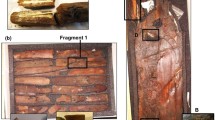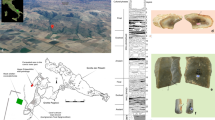Abstract
Molecular and supermolecular structures of fossilized resins from the North Eurasia have been studied in detail by IR-spectroscopy, atomic force microscopy (AFM), scanning (SEM), and high-resolution transmission electron (HRTEM) microscopy. The analysis of the IR-spectroscopy data allowed to identify the types of the fossil resins (succinite, rumanite, retinite, etc.). In the succinites and rumanite, the supermolecular structure was observed by AFM. Sizes of the supermolecular particles are 50–120 nm. Some chain-like and cluster-like aggregates can be observed when globules contact with each other. Using SEM and HRTEM techniques, it has been shown that mineral impurities are mainly located as scattered inclusions (from one nanometers up to several tens micrometers in size) in an amorphous organic matrix of the resin.











Similar content being viewed by others
References
Alekseeva AV, Samarina LA (1968) The question of the chemical structure of amber. Chem Nat Comp 2:351–356. doi:10.1007/BF00564222
Anderson KB, Crelling JC (1995) Amber, resinite, and fossil resins. American Chemical Society, Washington, DC, pp 170–192. doi:10.1021/bk-1995-0617.fw001
Baranov VA (2007) Quasicrystals of amber and other organic substances. Ukrainian Amber World, Proceedings of International conference, Kiev, pp 28–30
Barletta E, Wandelt K (2011) High resolution UHV-AFM surface analysis on polymeric materials: Baltic Amber. J Non-Cryst Sol 357:1473–1478. doi:10.1016/j.jnoncrysol.2010.12.039
Bartenev GM (1983) Physics and Mechanics of Polymers. Chemistry Press, Moscow
Beck CW (1986) Spectroscopic investigation of amber. Appl Spectrosc Rev 22:57–110. doi:10.1080/05704928608060438
Beck CW, Wilbur E, Meret S, Kossove D, Kermani K (1965) The infra-red spectra of amber and the identification of Baltic amber. Archaeometry 8:96–109. doi:10.1111/j.1475-4754.1965.tb00896.x
Bogdasarov MA (2007) Mineralogy of fossil resins in Northern Eurasia. Geol Ore Depos 49:630–637. doi:10.1134/S1075701507070215
Bogdasarov MA (2009) Amber and others Fossil Resins of Eurasia. University Press, Brest
Bogdasarov MA, Bushnev DA, Golubev YEA, Kovaleva OV, Shanina SN (2008a) Amber and amber-like fossil resins of Eurasia (part I). Izv VUZov, Geologiya i Razvedka 4:23–30
Bogdasarov MA, Bushnev DA, Golubev YEA, Kovaleva OV, Shanina SN (2008b) Amber and amber-like fossil resins of Eurasia (part II). Izv Vyssh Uchebn Zaved, Geol Razvedka 5:27–32
Brody RH, Edwards HGM, Pollard AM (2001) A study of amber and copal samples using FT-Raman spectroscopy. Spectrochim Acta A 57:1325–1338. doi:10.1016/S1386-1425(01)00387-0
Chiurca V, Vavra N (1990) Occurrence and chemical characterization of fossil resins from «Colti» (District of Buzau, Romania). N Jh Geol Paläont 5:283–294
Clifford DJ, Hatcher PG (1995) Structural transformations of polylabdanoid resinites during maturation. Org Geochem 23:407–418. doi:10.1016/0146-6380(95)00022-7
Feist M, Lamprecht I, Müller F (2007) Thermal investigations of amber and copal. Thermochim Acta 408:162–170. doi:10.1016/j.tca.2007.01.029
Gold D, Hazen B, Miller W (1999) Colloidal and polymeric nature of fossil amber. Org Geochem 30:971–983. doi:10.1016/S0146-6380(99)00083-2
Golubev YA, Kovaleva OV (2010) Nanostructurization in X-ray amorphous organic substances of geological origin. Russ Khim Zhur 54:103–109 [Engl. transl.: Russ J Gen Chem 81:1366–1374, (2011)]. doi:10.1134/S1070363211060417
Grimalt JO, Simoneit BRT, Hatcher PG, Nissenbaum A (1988) The molecular composition of ambers. Org Geochem 13:677–690. doi:10.1016/0146-6380(88)90089-7
Haris A, Adachi T, Araki W (2008) Nano-scale characterization of fracture surfaces of blended epoxy resins related to fracture properties. Mat Sci Eng A 496:337–344. doi:10.1016/j.msea.2008.06.030
Jehlička J, Edwards HGM (2008) Raman spectroscopy as a tool for the non-destructive identification of organic minerals in the geological record. Org Geochem 39:371–386. doi:10.1016/j.orggeochem.2008.01.005
Jehlička J, Villar SEJ, Edwards HGM (2004) Fourier transform Raman spectra of Czech and Moravian fossil resins from freshwater sediments. J Raman Spectrosc. 35:761–767. doi:10.1002/jrs.1191
Jehlička J, Edwards HGM, Villar SEJ, Pokorný J (2005) Raman spectroscopic study of amorphous and crystalline hydrocarbons from soils, peats and lignite. Spectrochim Acta A 61:2390–2398. doi:10.1016/j.saa.2005.02.018
Kosmowska-Ceranowicz B (1999) Succinite and some other fossil resins in Poland and Europe (deposits, finds, features and differences in IRS). Estud del Museo de Ciencias Nat de Alava 14:73–117
Kovalevski VV, Buseck PR, Cowley JM (2001) Comparison of carbon in shungite rocks to other natural carbons: an X-ray and TEM study. Carbon 39:243–256. doi:10.1016/S0008-6223(00)00120-2
Lambert JB, Frye JS, Poinar GO (1985) Amber from the Dominican Republic: analysis by nuclear magnetic resonance spectroscopy. Archaeometry 27:43–51. doi:10.1111/j.1475-4754.1985.tb00345.x
Lambert JB, Beck CW, Frye JS (1988) Analysis of European amber by carbon-13 nuclear magnetic resonance spectroscopy. Archaeometry 30:248–263. doi:10.1111/j.1475-4754.1988.tb00451.x
Martnez-Richa A, Vera-Graziano R, Rivera A, Joseph-Nathan P (2000) A solid-state 13C NMR analysis of ambers. Polymer 41:743–750. doi:10.1016/S0032-3861(99)00195-0
Mezzenga R, Plummer CJG, Boogh L, Manson JE (2001) Morphology build-up in dendritic hyperbranched polymer modified epoxy resins: modeling and characterization. Polymer 42:305–317. doi:10.1016/S0032-3861(00)00307-4
Mills JS, White R, Gough LJ (1984) The chemical composition of Baltic amber. Chem Geol 47:15–39. doi:10.1016/0009-2541(84)90097-4
Pereira R, Carvalho IS, Simoneit BRT, Azevedo D (2009) Molecular composition and chemosystematic aspects of Cretaceous amber from the Amazonas, Araripe and Recôncavo basins, Brazil. Org Geochem 40:863–875. doi:10.1016/j.orggeochem.2009.05.002
Perez J (1998) Physics and Mechanics of Amorphous Polymers. Taylor & Francis Press, Washington
Popkova TN (1984) Microharden of some amber fossil resins. Zapiski VMO (Proc USSR Mineral Soc) 1:128–133
Ragazzi E, Roghi G, Giaretta A, Gianolla P (2003) Classification of amber based on thermal analysis. Thermochim Acta 404:43–54. doi:10.1016/S0040-6031(03)00062-5
Rostiashvili VG, Irzhak VI, Rosenberg BA (1987) Polymer Glass-Transition. Chemistry Press, Leningrad
Savkevich SS (1970) Amber. Nedra, Leningrad
Savkevich SS (1981) Physical methods used to determine the geological origin of amber and other fossil resins: some critical remarks. Phys Chem Miner 7:1–4. doi:10.1007/BF00308192
Silvestre C, Cimmino S, D’Alma E, Di Lorenzo ML, Di Pace E (1999) Crystallization of isotactic polypropylene/natural terpene resins blends. Polymer 40:5119–5128. doi:10.1016/S0032-3861(98)00696-X
Srebrodolsky BI (1980) Ukrainian Amber. Naukova Dumka, Kiev
Stout EC, Beck CW, Kosmowska-Ceranowicz B (1995) Gedanite and gedano-succinite. Amer Chem Soc Symp ser 617:130–148
Stout EC, Beck CW, Anderson KB (2000) Identification of rumanite (Romanian amber) as thermally altered succinite (Baltic amber). Phys Chem Miner 9:0665–0678. doi:10.1007/s002690000111
Tazaki K, Tiba T, Aratani M, Miyachi M (1992) Structural water in volcanic glass. Clays Clay Mineral 40:122–127. doi:10.1346/CCMN.1992.0400113
Tonidandel L, Ragazzi E, Traldi P (2009) Mass spectrometry in the characterization of ambers. II. Free succinic acid in fossil resins of different origin. Rapid Commun Mass Spectrom 23:403–408. doi:10.1002/rcm.3886
Vavra N (2002) Fossil resin (“amber”) from the Paleocene of Renardodden (E cape Lyell, west Spitsbergen, Svalbard). Univ Hamburg, Geologisch-Paläontologische Institute, pp 263–277
Vavra N (2009) The chemistry of amber—facts, findings and opinions. Ann Naturhist Mus Wien 111:445–474
Villanueva-García M, Martínez-Richa A, Robles J (2005) Assignment of vibrational spectra of labdatriene derivatives and ambers: a combined experimental and density functional theoretical study. Arkivoc vi:449–458
Wang H (1989) A mineralogical study of amber from Xixia region, Henan Province. Kuangwu Xuebao 9:338–344
Yushkin NP, Sergeeva ND (1974) Textural features of Yugorian amber. Dokl Akad Nauk SSSR 216:637–640
Acknowledgments
This research was funded partially by The Programs of Presidium of Russian Academy of Science no. 09-C-5-1022, 27, Scientific School (grant 7198.2010.5). Authors thank Vasily N. Filippov for the realization of the X-ray spectral analysis. The authors are grateful to Dr. Elena Suvorova for the TEM observations. The support of the Centre Interdisciplinaire de Microscopie Electronique of the Ecole Polytechnique Fédérale de Lausanne is acknowledged for making available the electron microscope. We are especially grateful to Dr. Maxim A. Bogdasarov for fossil resin samples and consultation. We also thank reviewers of this work for their remarks and wording assistance.
Author information
Authors and Affiliations
Corresponding author
Rights and permissions
About this article
Cite this article
Golubev, Y.A., Martirosyan, O.V. The structure of the natural fossil resins of North Eurasia according to IR-spectroscopy and microscopic data. Phys Chem Minerals 39, 247–258 (2012). https://doi.org/10.1007/s00269-011-0480-x
Received:
Accepted:
Published:
Issue Date:
DOI: https://doi.org/10.1007/s00269-011-0480-x




